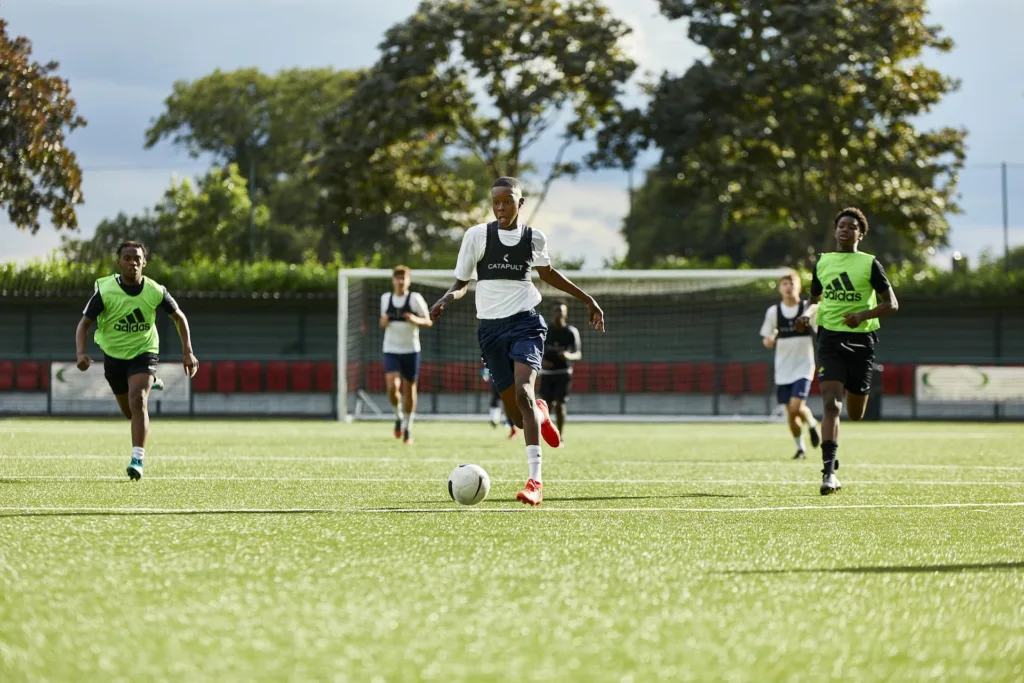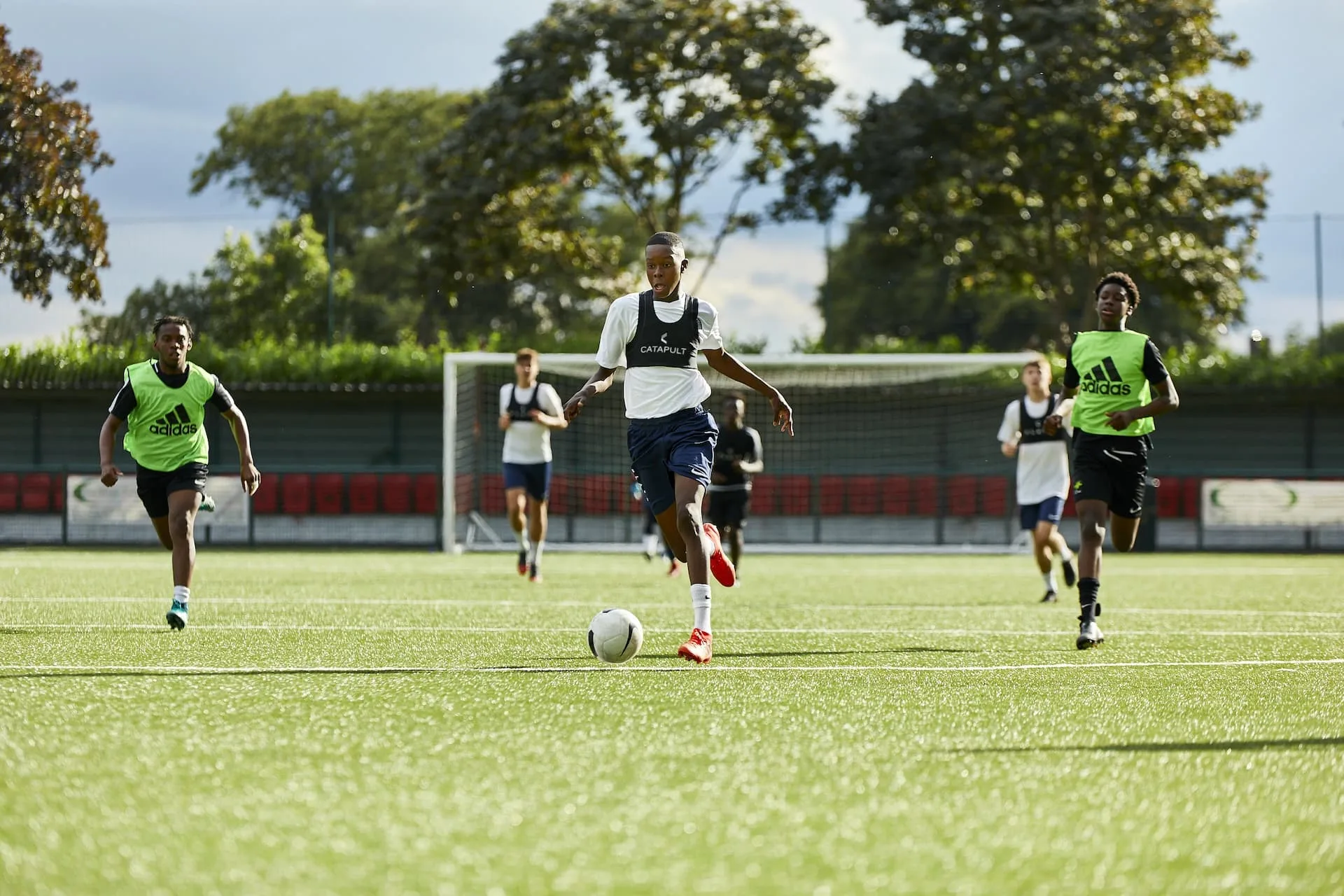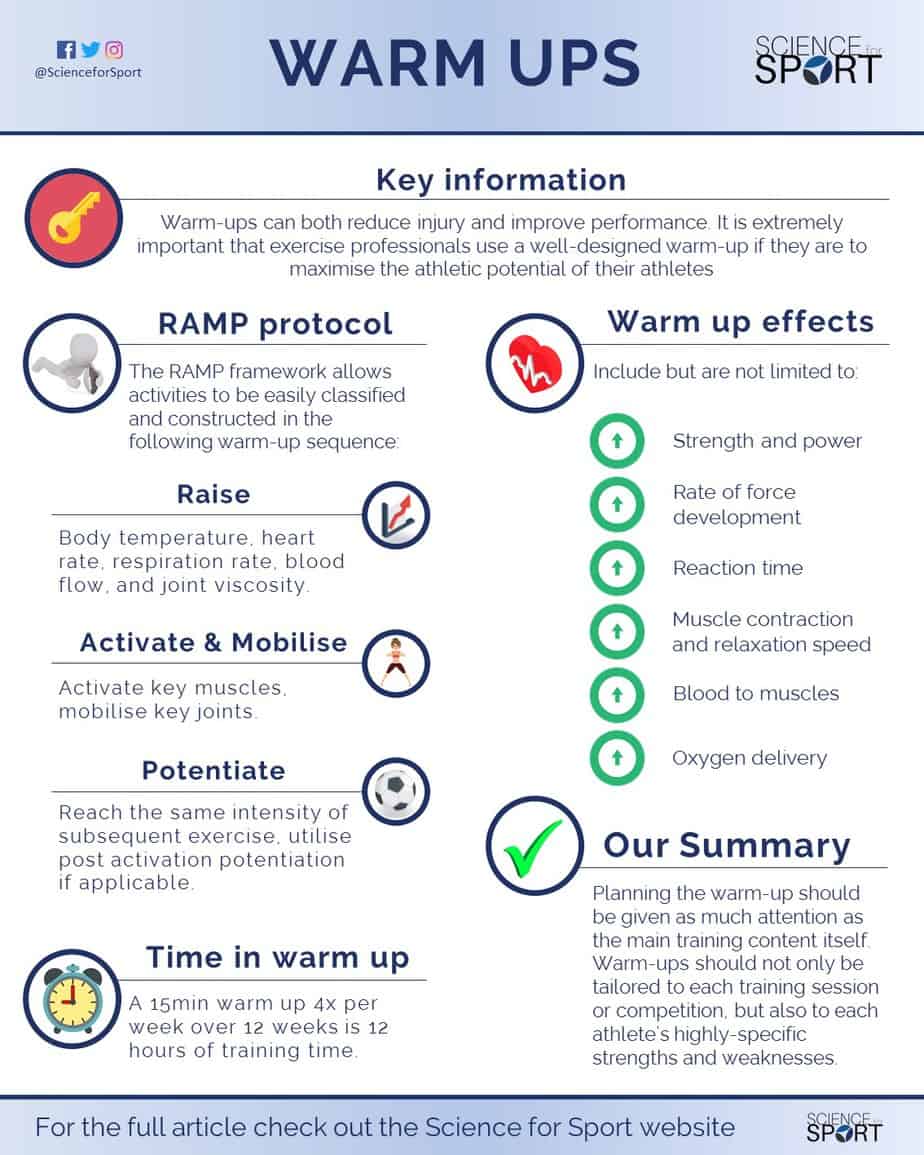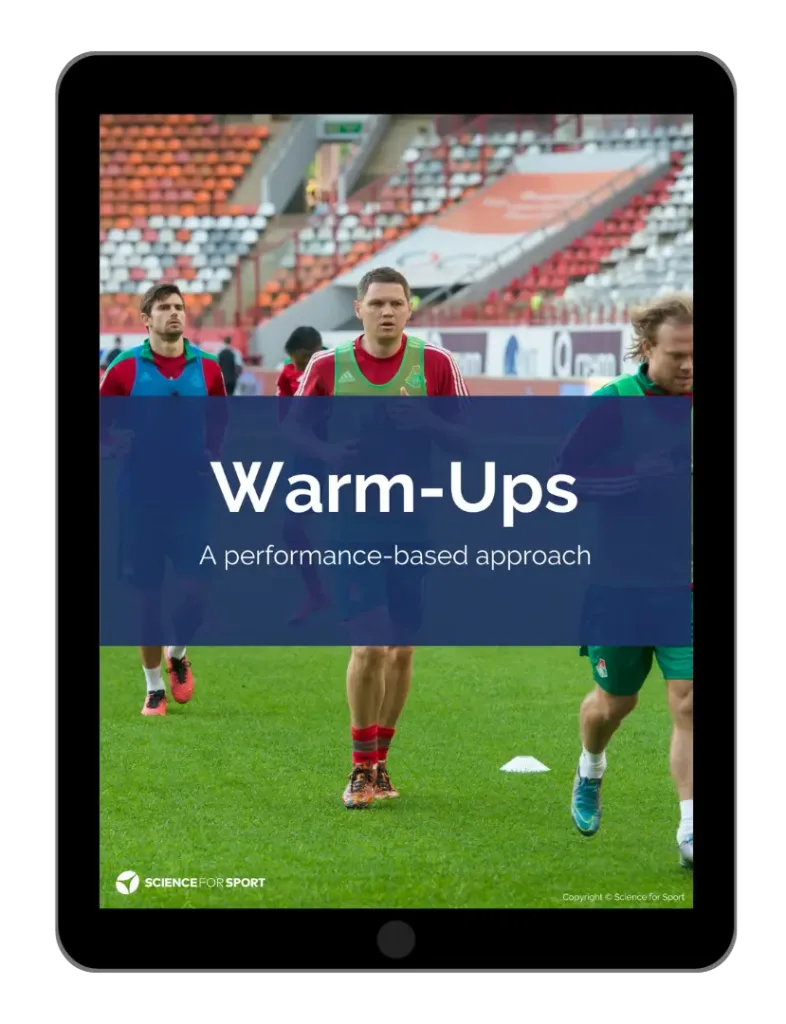Contents of Article
- Summary
- Are warm-ups important?
- What are the best warm-ups to do?
- Is stretching required in a warm-up?
- How do you plan an effective warm-up?
- How do you optimise a warm-up?
- Conclusion
- About the Author
- References
Summary
A well-planned warm-up has the potential to not only prepare athletes physically and mentally but also possess the ability to reduce the likelihood of injury and improve performance, highlighting its significant importance in athletic development. This article discusses the current warm-up practices conducted by elite and professional athletes and also provides a new modified model of the RAMP protocol developed by Dr. Ian Jeffreys.

Are warm-ups important?
Yes, warm-ups are a vital component for preparing the body for strenuous physical activity, such as sport or gym-based exercise. A well-conducted warm-up can help improve performance and reduce the risk of injury.
The practice of ‘warming up’ has been universally accepted for a very long time. While the general principles surrounding the need to warm-up remain valid, in recent years there has been growing evidence that questions the usefulness of historic warm-up methods and introduces potential areas for future development.
In past years, particularly within recreational and amateur sport environments, warm-ups were typically employed to serve only two purposes: 1) to prepare the athlete mentally, and 2) to prepare the athlete physically for exercise or competition. However, in recent years whilst the same principles apply, warm-ups are now often viewed to serve four primary purposes:
- Mental readiness
- Physical readiness
- Injury prevention
- Performance enhancement
In professional and elite sports environments, using warm-ups to serve these four primary purposes appears to now be very common. As a consequence, warm-ups have evolved to also serve as a method of enhancing performance and reducing or preventing the occurrence of injury. In most of these professional and elite environments, the days of a simple two-minute jog around the field, followed by some poorly coached and light-hearted static stretching, are rapidly vanishing due to modern knowledge and the accessibility of information.
As it is understood warm-ups can both reduce injury (1, 2) and improve performance (3, 4, 5), it is extremely important that exercise professionals understand not only the importance but also the potential of a well-designed warm-up if they are to maximise the athletic potential of their athletes.
A well-designed warm-up can increase blood flow, muscle temperature, and core temperature (6), and also disrupt temporary connective tissue bonds (7). These effects can have the following positive effects on performance:
- Faster muscle contraction and relaxation of both agonist and antagonist muscles (8).
- Improvements in the rate of force development (9).
- Improvements in reaction time (9).
- Improvements in muscle strength and power (10, 7).
- Lowered viscous resistance in muscles (7)
- Improved oxygen delivery due to the Bohr effect where higher temperatures facilitate oxygen release from haemoglobin and myoglobin (6)
- Increased blood flow to active muscles (6)
- Enhanced metabolic reactions (7)
What are the best warm-ups to do?
Warm-ups most commonly last for approximately 10-30 minutes, meaning all desired content must be strategically factored in this short period of time. Though each warm-up is short, over a long time frame such as a 12-week training cycle, the accumulation of a 10-30 minute warm-up each session equates to a huge increase in total training time. For example:
- A 15-minute warm-up performed 4 x per week for 12 weeks = 12 hours of training time.
Over a 12-week training cycle, the exercise professional can utilise an additional 12 hours of high-quality training time. This further demonstrates the importance and potential of a strategic and effective warm-up.
In an attempt to advance current performance preparation practices, two primary warm-up models have been developed by Dr. Ian Jeffreys (2007) (4), and Mark Verstegen (2004) (11). The framework “RAMP” protocol developed by Dr. Jeffreys allows for activities to be easily classified and constructed in the following warm-up sequence:
- Raise
- Activate and Mobilise
- Potentiate (or Performance in this article’s modified variation of the RAMP protocol)
It should be the aim of the exercise professional to have the athletes fully prepared both mentally and physically following the end of the third phase (i.e. potentiation phase) of the RAMP protocol and ready for competition or activity. Each of the three phases of this warm-up model plays an important role in the athlete’s preparation.
Phase 1 – Raise
The aim of the ‘raise’ section is to:
- ↑ Body temperature
- ↑ Heart rate
- ↑ Respiration rate
- ↑ Blood flow
- ↑ Joint viscosity
Although this is often a common practice in the form of a ‘jog around the field’, this is often viewed as a large waste of valuable training time. Whilst the primary aims of this section should match those listed above, it can and perhaps should be performed using exercises or simplified sports-specific movements which will be abundant during the session. For example, if the athletes are preparing for a technical rugby session, then this section of the warm-up may include low-intensity, multi-directional movements or dynamic range of motion exercises which will be abundant during the session. Some examples of raise exercises may include:
- Sprint technique drills (A-skips, B-skips, Bicycles, Heel cycling, Waterfalls)
- Planned change of direction drills
- Squatting, lunging, or crawling.
Phase 2 – Activate and Mobilise
The aim of this phase of the warm-up is two-fold:
- Activate key muscle groups
- Mobilise key joints and ranges of motion used in the sport or activity
During this phase of the warm-up, typical activation and mobilisation movements include:
- Mini-band routines
- Balance work
- Supermans and inchworms
- Squats and lunges
- Sumo shuffles
- Spinal mobility exercises (flexion, extension, lateral flexion, and rotation)
These exercises may be used for the majority, if not all of the athletes competing in the same training session or activity. However, after the generic group movement exercises have been completed, stricter attention should be paid to individual preparation requirements. For instance, this may involve exercises prescribed in the athlete’s pre-habilitation programme such as specific joint mobilisation exercises, glute-ham exercises, mini-band routines, rotator cuff exercises, balance work and so on. Incorporating these exercises into the warm-up may result in better time utilisation, and therefore perhaps lead to a reduced injury risk and improved performance.
When designing the activation and mobilisation phase, it is essential the strength and conditioning coach carefully considers the fundamental movements and demands imposed by that particular sport or activity. For example, what fundamental movements will occur during a rugby match, or during an Olympic Weightlifting session in the gym? This will allow the coach to be very specific with the movements/exercises selected for the warm-up and therefore have the best possible chance to effectively prepare the athletes for training or competition and prevent them from injury.
It is encouraged that coaches develop numerous exercises that activate and mobilise the same key muscles, joints, and ranges of motion which can be used for training variability to prevent monotony and emphasise performance improvements. In addition, some exercises may irritate or be painful for some athletes, so having an assortment of backup exercises for the same joints and muscle groups is vital.
Phase 3 – Potentiation or Performance (modified version)
The aim of this phase is to ‘prime’ the athletes for their session or competition.
This phase of the warm-up is fixated on exercises that will directly lead to performance improvements in the following activities. Developed using the principle of post-activation potentiation, this phase of the warm-up will now begin to unidentifiably transit into the workout/sport itself, meaning it will begin to incorporate sports-specific activities using rising intensities. This phase serves two primary objectives:
- ↑ Intensity to a comparable level the athletes’ are about to compete in.
- ↑ Improve subsequent performance utilising the effects of post-activation potentiation.
Therefore, the content of the potentiation/performance phase will see high-intensity drills that are highly specific to the sport. For example, the potentiation phase of a sprint session may include sprint-specific drills such as 5-10 m accelerations, rolling 30-40 m sprints, plyometrics and so on. In team-based sports such as football (soccer), this may include the use of plyometrics, reactive agility drills in a chaotic environment, and sprints using various intensities and distances.
An example of potentiation/performance exercises for a technical rugby session may include:
- Plyometric exercises (unilateral and bilateral jumps and bounds)
- Short-moderate distance accelerations and sprints (0-20 m)
- Involvement of tackling pads
- Reactive agility drills (e.g. evasion games in chaotic environments)
After the completion of these three phases and gradually increasing the intensity of the exercises as the warm-up progresses, the athletes should be sufficiently prepared physically for the forthcoming session or competition. Though there are no guidelines in this model in regards to the duration of each phase, this is something that should be tailored by the strength and conditioning coach based on several factors such as time availability, the athlete’s physical requirements, and content of the main session – to name just a few. Further information on time management for the warm-up is provided in later sections of this article.
Is stretching required in a warm-up?
Notice how static stretching was not mentioned or included throughout the performance preparation procedure? This has perhaps been the largest debate with regards to warming up over the past several decades.
Although it has always been a cornerstone component of warming up as a method to decrease injury risk and improve performance, there is little evidence, if any, to indicate that pre- or post-exercise static stretching reduces injury (12, 13, 14, 15, 16). Additionally, there is growing research to suggest that pre-exercise static stretching also compromises subsequent performance by reducing force production (17, 18), power output (19), running speed (20), reaction time (21), and strength endurance (22).
Dynamic stretching, however, has been consistently shown to improve subsequent performance (20, 23). Additionally, because dynamic stretching requires the muscle to activate through a range of movements, it is believed that this contributes to the neural activation requirements of warm-ups. As a result, dynamic stretching may be the most appropriate form of mobilisation during warm-ups for most activities and sports which are dynamic in nature.
How do you plan an effective warm-up?
To plan an effective warm-up, the strength and conditioning coach must first understand the mental, physiological, and biomechanical demands of the training session or sport before they attempt to prepare the athlete for these precise demands. In most circumstances, these demands are identified during the needs analysis.
For example, if a strength and conditioning coach is planning a warm-up for some 1 repetition maximum (RM) testing, then they might want to consider what the mental, physiological, and biomechanical demands of that session are. For mental preparation, the coach may encourage the athletes to arrive well-rested and to bring personal self-motivating music to listen to whilst testing – as this has been repeatedly shown to improve performance (24).
To prepare them physiologically, the coach may adopt a warm-up routine with mimics similar physiological demands to 1RM testing, such as high-force/strength, long-rest exercises. In terms of biomechanical preparation, stretches, dynamic movements and exercises similar to those being performed during testing would be appropriate (e.g. back squatting).
Alternatively, if a strength and conditioning coach is designing a pitch-based warm-up for a ‘short and sharp’ technical session for football (soccer), then the warm-up should be designed specifically for that session and therefore may look very different to the previous 1RM testing example. The mental preparation may likely be very different, as the players’ mental readiness may be stimulated by competing against other players – as an example.
Physiologically, if the technical session demands high-work volumes with short recovery periods, and thus a high cardiovascular demand, then the warm-up should aim to produce similar or even replicate the intensities the athletes will be exposed to. From a biomechanical standpoint, the adopted movements should have biomechanical similarities to the movements which will be prevalent during the technical session. This may include things such as lunges, directional changes, jumping, and twisting movements.
Remember that the warm-up can be structured effectively and strategically using the RAMP protocol and that the content/exercises should replicate those of the session the athletes are preparing for.
How do you optimise a warm-up?
As mentioned previously, as the training time for each warm-up can accumulate to a large number of training hours over a long period of time, finding ways to optimise a performance gain from the use of a warm-up may be extremely beneficial. One way to structure a warm-up in order to optimise its effectiveness is by adapting the RAMP protocol and adjusting the ‘Potentiation’ component to have a larger ‘Performance’ improvement emphasis. The strength and conditioning coach may, therefore, direct more attention towards improving athletic performance during the warm-ups, rather than simply preparing them for their session. This method simply attempts to maximise training efficiency and effectiveness.
The strength and conditioning coach first identifies their current training objective and then tailors the latter part of the warm-up to achieve this goal. For example, if the coach’s objective is to educate fundamental plyometric movements and finally progress to high-quality and high-intensity plyometrics, then they may structure the ‘Performance’ section of the modified RAMP protocol towards achieving this goal. Alternatively, if the coach’s objective was to develop speed or agility, then the latter part of the warm-up would simply involve speed or agility drills designed to optimise either one or both of these qualities. More specifically, if the coach wished to develop a particular aspect of agility (e.g. change of direction speed or reactive agility), then the ‘Performance’ section of the warm-up should be specifically tailored to improve these qualities. As a result, a 20-minute technical rugby session warm-up designed to improve agility, with an emphasis on reactive agility, may look like the following:
Raise (5-minutes)
- Low-intensity randomised passing drill in a box (20 m x 20 m box)
- Or, acceleration mechanics (e.g. wall high knees drill)
Activate and Mobilise (5-minutes)
- Sport-specific activation and mobilisation movements such as glute-band circuits, superman’s, lunges, squats, sumo shuffles, spinal mobilisation exercises.
Performance (10-minutes)
- 30:70 ratio* (Change of Direction Speed: Reactive Agility)
- Change of Direction Speed – Structured/ pre-planned movements (e.g. cone drills)
- Reactive Agility – An evasion game (e.g. British Bulldog and variations)
*The time spent on either of these qualities should be dictated by the athlete’s competencies in performing them. For instance, an athlete who needs to work on their change of direction mechanics should spend more training time on this component (e.g. an 80:20 change of direction speed: reactive agility ratio).
Though the performance component may only comprise 10 minutes of the warm-up, constructing a warm-up in this way optimises the athlete’s total training hours over a long training cycle – e.g. 10mins x 4 days a week for 12 weeks equals an extra eight hours of performance-based training.
The performance component (e.g. agility, plyometrics, or speed) can, and perhaps should be changed regularly. For instance, weeks 1-4 of a training cycle may focus on speed development, whilst weeks 5-9 may focus on agility development. Alternatively, the coach may wish to change these performance components on a daily basis. Whereby training day 1 (e.g. Monday) may focus on speed development, and training day 2 (e.g. Tuesday) may focus on plyometrics and so on. The coach may also wish to be more specific with their approach and tailor each performance component of the warm-up to each athlete’s individual needs.
This performance-based modification of the RAMP protocol should, in theory, maximise training efficiency, and thus optimise the overall training effect – meaning a greater improvement in athletic performance can be achieved. However, this is subject to the design and facilitation of the warm-up.
Though there is little scientific justification for this particular training protocol at present, it does provide a well-planned and strategic example of a new performance-based approach to warm-ups.
Conclusion
Planning the warm-up should be given as much attention as the main training content itself, and the content of the warm-up should be relevant and harmonious with the specific training session objectives. For example, a training session that is primarily focussed upon maximising an athlete’s explosive jump capacity (which will include the use of plyometrics) should incorporate the use of ‘priming’ exercises such as lower-limb movements (e.g. squats and lunges), hopping, jumping, and landing. All of these should be progressively planned and translate unidentifiably into the main content (exercises) of the session.
Because well-designed warm-ups have been continuously proven to reduce injuries and enhance performance, exercise professionals should pay great attention to the objectives and content of every warm-up delivered. Furthermore, warm-ups should not only be tailored to each training session or competition but also to each athlete’s highly specific strengths and weaknesses.
- Malliou P, Rokka S, Beneka A, Mavridis G, and Godolias G. Reducing risk of injury due to warm up and cool down in dance aerobic instructors. J Back Musculoskelet Rehabil 20: 29–35, 2007. https://www.researchgate.net/publication/263851860_Reducing_risk_of_injury_due_to_warm_up_and_cool_down_in_dance_aerobic_instructors
- Barengo, N.C Meneses-Echávez, J.F., Ramírez-Vélez, R., Cohen, D.D., Tovar, G., & Bautista, J.E.C. (2014). The Impact of the FIFA 11+ Training Program on Injury Prevention in Football Players: A Systematic Review. 2015. International Journal of Environmental Research and Public Health, 11(11), pp.11986–12000. http://www.ncbi.nlm.nih.gov/pubmed/25415209
- DeRenne, C. (2010). Effects of Postactivation Potentiation Warm-up in Male and Female Sport Performances: A Brief Review. Strength and Conditioning Journal, 32(6), pp.58-64. https://www.researchgate.net/publication/232179109_Effects_of_Postactivation_Potentiation_Warm-up_in_Male_and_Female_Sport_Performances_A_Brief_Review
- Jeffreys, I. (2007). Warm-up revisited: The ramp method of optimizing warm-ups. Professional Strength and Conditioning. (6) 12-18. https://www.researchgate.net/publication/280945961_Jeffreys_I_2007_Warm-up_revisited_The_ramp_method_of_optimizing_warm-ups_Professional_Strength_and_Conditioning_6_12-18
- Costa, P.B., Medeiros, B.D.O., & Fukuda, D.H. (2011). Warm-up, Stretching, and Cool-down Strategies for Combat Sports. Strength and Conditioning Journal, 33(6), pp.71-79. https://www.researchgate.net/publication/232214628_Warm-up_Stretching_and_Cool-down_Strategies_for_Combat_Sports
- McArdle WD, Katch Fi and Katch VL. Exercise Physiology: Energy, Nutrition and Human Performance (Fifth Ed) Baltimore: Lippincott Williams and Wilkins 2001. http://www.amazon.com/Exercise-Physiology-Energy-Nutrition-Performance/dp/0781725445
- Enoka, RM. Neuromechanics of Human Movement. Champaign Ill: Human Kinetics 2002. https://books.google.com.au/books/about/Neuromechanics_of_Human_Movement.html?id=-dtPqXEzo44C&redir_esc=y
- Hoffman J. Physiological Aspects of Sports Performance and Training. Champaign Ill: Human Kinetics 2002 http://www.humankinetics.com/products/all-products/physiological-aspects-of-sport-training-and-performance-with-web-resource-2nd-edition
- Asmussen E, Bonde-Peterson F and Jorgenson K. Mechanoelastic properties of human muscles at different temperatures. Acta Physiologica Scandinavica. 96:86–93 1976. http://www.ncbi.nlm.nih.gov/pubmed/1251749
- Bergh U and Ekblom B. Influence of muscle temperature on maximal strength and power output in human muscle. Acta Physiologica Scandinavica 107:332–337 1979. http://www.ncbi.nlm.nih.gov/pubmed/525366
- Verstegen, M and Williams P. Core performance. Rodahl: New York 2004. http://www.amazon.com/Core-Performance-Revolutionary-Workout-Transform/dp/1594861684
- Herbert RD and Gabriel M. Effects of stretching before and after exercise on muscle soreness and risk of injury: a systematic review. Br Med J: 325: 468–470 2002. http://www.ncbi.nlm.nih.gov/pubmed/12202327
- Pope RP, Herbert RD, Kirwan JD et al. A randomised trial of pre-exercise stretching for prevention of lower limb injury. Med Sci Sports Exerc. 32: 271–277 2000. http://www.ncbi.nlm.nih.gov/pubmed/10694106
- Shrier I. Stretching before exercise does not reduce the risk of local muscle injury: a critical review of the clinical and basic science literature. Clin J Sport Med. Oct;9(4):221–7 1999. http://www.ncbi.nlm.nih.gov/pubmed/10593217
- Shrier I. Stretching before exercise: an evidence based approach. Br J Sports Med. Oct;34(5):324–5 2000. http://www.ncbi.nlm.nih.gov/pmc/articles/PMC1756248/
- Thacker SB, Gilchrist J, Stroup DF, Kimsey CD Jr. The impact of stretching on sports injury risk: a systematic review of the literature. Med Sci Sports Exerc. Mar;36(3):371–8 2004. http://www.ncbi.nlm.nih.gov/pubmed/15076777
- Cramer JT, Housh TJ, Weir JP, Johnson GO, Coburn JW, Beck TW. The acute effects of static stretching on peak torque, mean power output, electromyography, and mechanomyography. Eur J Appl Physiol. Mar;93(5- 6):530–9 2005. http://www.ncbi.nlm.nih.gov/pubmed/15599756
- Cramer JT, Housh TJ, Coburn JW, Beck TW, Johnson GO. Acute effects of static stretching on maximal eccentric torque production in women. J Strength Cond Res. May;20(2):354–8 2006. http://www.ncbi.nlm.nih.gov/pubmed/16686563
- Wallmann HW, Mercer JA, McWhorter JW. Surface electromyographic assessment of the effect of static stretching of the gastrocnemius on vertical jump performance. J Strength Cond Res. Aug;19(3):684–8 2005 http://www.ncbi.nlm.nih.gov/pubmed/16095426
- Fletcher IM, Jones B. The effect of different warm-up stretch protocols on 20 meter sprint performance in trained rugby union players. J Strength Cond Res. Nov;18(4):885–8 2004. http://www.ncbi.nlm.nih.gov/pubmed/15574098
- Behm DG, Bambury A, Cahill F, Power K. Effect of acute static stretching on force, balance, reaction time, and movement time. Med Sci Sports Exerc. Aug; 36(8):1397–402 2004. http://www.ncbi.nlm.nih.gov/pubmed/15292749
- Nelson AG, Kokkonen J, Arnall DA. Acute muscle stretching inhibits muscle strength endurance performance. J Strength Cond Res. May;19(2):338–43 2005. http://www.ncbi.nlm.nih.gov/pubmed/15903372
- Little T, Williams AG. Effects of differential stretching protocols during warm-ups on high-speed motor capacities in professional soccer players. .J Strength Cond Res. Feb;20(1):203–7 2006. http://www.ncbi.nlm.nih.gov/pubmed/16503682
- Karageorghis, C.I. & Terry, P.C. (1997). The psychophysical effects of music in sport and exercise: a review. Journal of Sport Behaviour, Vol. 20, Issue 1. https://www.researchgate.net/publication/228668613_Psychophysical_effects_of_music_in_sport_and_exercise_an_update_on_theory_research_and_application




